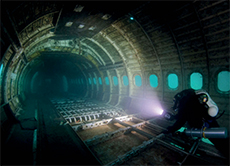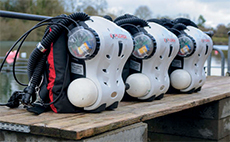




| Home | Features | Club Nights | Underwater Pics | Feedback | Non-Celebrity Diver | Events | 19 April 2024 |
| Blog | Archive | Medical FAQs | Competitions | Travel Offers | The Crew | Contact Us | MDC | LDC |

|

|
 
 |
  ISSUE 20 ARCHIVE - HOLLIS REBREATHERRyby StonehouseIt's about time... time to get serious underwater that is. Everybody has been there at some stage; you're down on the wreck and your computer is saying only 3 minutes 'no-stop time' remaining. Either that or you're dancing dangerously close to a less than desirable amount of air being left in your cylinder. Both of these things mean only one thing: you have to call time on the dive. Damn, you haven't even seen the propeller yet!So what are your options to eliminate this from happening on any future dives?
Here are a few advantageous facts for Sport Rebreather Diving:
I started diving the Hollis Explorer Sports Rebreather in early 2013 and was hooked from the very first dive. 100 minutes following a multi-level recreational profile from 35m up to 18m, staying clear of no-stop limits and having a great time with turtles and eagle rays, it was in Cozumel at 28*C with 30m+ viz. However it wasn't the stunning environment that made it memorable, it was just how EASY the unit was to operate. The Explorer is almost idiot proof (hence why I am using it) it has only one cylinder of Nitrox 32-40% to think about, making it far less complicated than other more 'tekkie' style rebreathers. The Explorer Sports Rebreather is designed for use by newly qualified recreational divers (who are qualified to dive above 18m) but it's true potential is achieved in the 18-30m range where time and gas would usually restrict dive time for open circuit scuba divers. With this in mind I would say that an advanced qualification or more experience at a greater depth is recommended when embarking on your rebreather journey. Having now run Explorer try-dives and courses for a long, long line of enthusiastic divers, I can genuinely say that every one of them "got it" within the first 10 minutes of being underwater, and most importantly, every one of them loved it! For those of you with an inquisitive mind there are several key features of this rebreather that make it uniquely simple and effective, and considering this isn't an especially in-depth technical review, nor does it claim to be, I would encourage all who are interested to search online to find out more. Essentially the Explorer is an electronic semi-closed rebreather, so it farts out a small trickle of bubbles every 5th or 6th breath, and due to a clever little widget called a "loop control valve" it makes it so much easier to control buoyancy and breathing than other units (this is just in my personal opinion not a technical specification - but suck it and see for yourself!). The electronics are very clever in what they do for you in extending dive time (remember that's what its all about) but are incredibly simple to use. An eye line "heads up display" (HUD) gives you constant status updates: green light is good, green/blue signals more info to read on wrist computer and of course flashing red equals a serious problem. Additionally the 'bailout' red light vibrates so that you won't miss it (trust me it shakes the fillings in your teeth!). The wrist unit is clear and uncluttered, showing depth, dive time, and how long you have left at depth, perfect! So, it's easy to use and if used correctly it gives you a longer and more enjoyable dive. The course I am most familiar with for the Hollis Explorer Sports Rebreather includes a crew pack with manual & DVD for home study and then progresses onto a theory class and practical session, leading into pool dives. You will then complete 6 open water dives over 3 days of diving. So if it's time you're after - come Explorering ! |